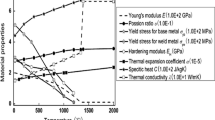Abstract
In this study, an effective artificial neural network (ANN) model was established to predict the bending deformation in a welded square thin-walled aluminum alloy tube structure. The input variables of the ANN model include four controllable positional parameters of welding, whereas the bending deformations in the X-axis and Y-axis directions are considered the target outputs. To estimate the bending distortion rapidly and accurately, a supervised multilayer feed-forward backpropagation (BP) neural network was proposed. A total of 270 finite element (FE) numerical simulations were performed to generate a database for training the designed ANN model. Moreover, a series of experiments were conducted to confirm the accuracy of the FE models. The predicted values from the designed BP neural network and the FE simulation results were compared to evaluate the performance of the proposed ANN model. The comparative study demonstrated that the proposed BP neural network model can accurately predict welding-induced bending deformations within an available range of welding position parameters.
















Similar content being viewed by others
References
Kong BS, Park DK (2018) Design optimization of the cowl cross bar-light cowl cross bar satisfying 5 performances. Int J Automot Technol 19(2):387–391. https://doi.org/10.1007/s12239-018-0037-9
Masubuchi K (1980) Analysis of welded structures: residual stresses, distortion and their consequences, Pergamon Press. England, Oxford
Wu C, Kim JW (2020) Numerical prediction of deformation in thin-plate welded joints using equivalent thermal strain method, Thin Wall. Struct. 157:107033. https://doi.org/10.1016/j.tws.2020.107033
Sun J, Liu X, Tong Y, Deng D (2014) A comparative study on welding temperature fields, residual stress distribution and deformations induced by laser beam welding and CO2 gas arc welding. Mater Design 63:519–530. https://doi.org/10.1016/j.matdes.2014.06.057
Deng D, Zhou Y, Bi T, Liu X (2013) Experimental and numerical investigations of welding distortion induced by CO2 gas arc welding in thin-plate bead-on joints. Mater Design 52:720–729. https://doi.org/10.1016/j.matdes.2013.06.013
Fu G, Lourenco MI, Duan M, Estefen SF (2014) Effect of boundary conditions on residual stress and distortion in T-joint welds. J Constr Steel Res 102:121–135. https://doi.org/10.1016/j.jcsr.2014.07.008
Manurung YHP, Lidam RN, Rahim MR, Zakaria MY, Redza MR, Sulaiman MS, Tham G, Abas SK (2013) Welding distortion analysis of multipass joint combination with different sequences using 3D FEM and experiment. Int J Press Vessel Pip 111-112:89–98. https://doi.org/10.1016/j.ijpvp.2013.05.002
Wu C, Lee C, Kim JW (2020) Numerical simulation of bending deformation induced by multi-seam welding of a steel-pipe structure. J Mech Sci Technol 34:2121–2131. https://doi.org/10.1007/s12206-020-0433-8
Velaga SK, Rajput GR, Murugan S, Ravisankar A, Venugopal S (2015) Comparison of weld characteristics between longitudinal seam and circumferential butt weld joints of cylindrical components. J Manuf Process 18:1–11. https://doi.org/10.1016/j.jmapro.2014.11.002
Shanavas S, Dhas JER (2018) Weld quality prediction of AA 5052-H32 aluminum alloy using neural network approach. Mater Today Proc 5:8256–8262. https://doi.org/10.1016/j.matpr.2017.11.516
Anand K, Barik BK, Tamilmannan K, Sathiya P (2015) Artificial neural network modeling studies to predict the friction welding process parameters of Incoloy 800H joints. Eng Sci Technol 18:394–407. https://doi.org/10.1016/j.jestch.2015.02.001
Chokkalingham S, Chandrasekhar N, Vasudevan M (2012) Predicting the depth of penetration and weld bead width from the infra red thermal image of the weld pool using artificial neural network modeling. J Intell Manuf 23:1995–2001. https://doi.org/10.1007/s10845-011-0526-4
Juang SC, Tarng YS, Lii HR (1998) A comparison between the back-propagation and count-propagation networks in the modeling of the TIG welding process. J Mater Process Technol 75:54–62. https://doi.org/10.1016/S0924-0136(97)00292-6
Ahmadzadeh M, Hoseini Fard A, Saranjam B, Salimi HR (2012) Prediction of residual stresses in gas arc welding by back propagation neural network. NDT&E Int 52:136–143. https://doi.org/10.1016/j.ndteint.2012.07.009
Tian L, Luo Y, Wang Y, Wu X (2014) Prediction of transverse and angular distortions of gas tungsten arc bead-on-plate welding using artificial neural network. Mater Design 54:458–472. https://doi.org/10.1016/j.matdes.2013.08.082
Choobi MS, Haghpanahi M, Sedighi M (2012) Prediction of welding-induced angular distortions in thin butt-welded plates using artificial neural networks. Compos Mater Sci 62:152–159. https://doi.org/10.1016/j.commatsci.2012.05.032
Goldak J, Chakravarti A, Bibby M (1984) A new finite element model for welding heat sources. Metall Trans B 15:299–305. https://doi.org/10.1007/BF02667333
Wang X, Zhang C, Li P, Wang K, Hu Y, Zhang P, Liu H (2012) Modeling and optimization of joint quality for laser transmission joint of thermoplastic using an artificial neural network and a genetic algorithm. Opt Lasers Eng 50:1522–1532. https://doi.org/10.1016/j.optlaseng.2012.06.008
Ghetiya ND, Patel KM (2014) Prediction of tensile strength in friction stir welded aluminum alloy using artificial neural network. Procedia Technology 14:274–281. https://doi.org/10.1016/j.protcy.2014.08.036
Funding
This work was supported by a 2020 Yeungnam University Research Grant.
Author information
Authors and Affiliations
Corresponding author
Ethics declarations
Ethics approval
This manuscript is our original unpublished work, and it has not been submitted to any other journal for review.
Consent to participate
Not applicable. The article involves no studies on humans.
Consent for publication
All authors have consented to publication.
Conflict of interest
The authors declare no competing interests.
Additional information
Publisher’s note
Springer Nature remains neutral with regard to jurisdictional claims in published maps and institutional affiliations.
Rights and permissions
About this article
Cite this article
Wu, C., Wang, C. & Kim, W. Bending deformation prediction in a welded square thin-walled aluminum alloy tube structure using an artificial neural network. Int J Adv Manuf Technol 117, 2791–2805 (2021). https://doi.org/10.1007/s00170-021-07884-9
Received:
Accepted:
Published:
Issue Date:
DOI: https://doi.org/10.1007/s00170-021-07884-9



